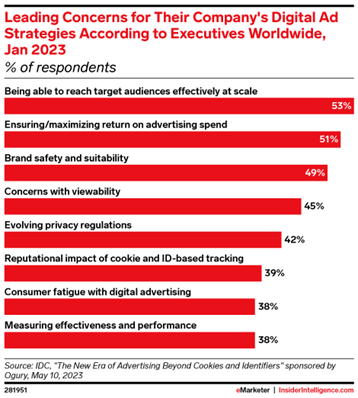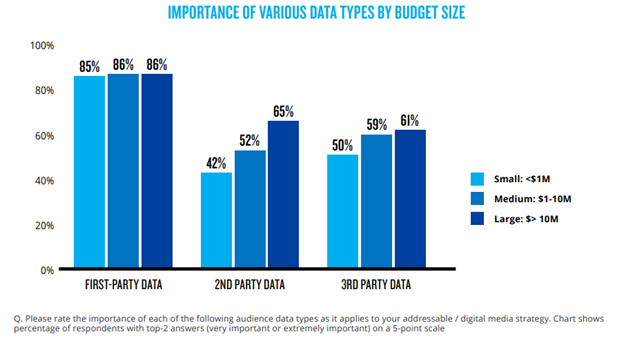As of January 4th, 2024, Google began blocking cookies for 1% of Chrome users, or about 30 million people. This is the long-awaited final step of its Privacy Sandbox initiative, marking the end of the third-party cookie era.
The phasing out of third-party cookies, which were a cornerstone of digital advertising, is a response to growing concerns about user privacy. As cookies lose their efficacy, brands face the challenge of delivering personalized and targeted marketing campaigns while respecting user privacy and complying with regulations.
However, not enough marketers are fully prepared. As of a May 2023 Adobe study, 75% of marketers still rely heavily on third-party cookies.
In other notable stats, over half (53%) of executives worldwide say their leading concern regarding their digital advertising strategy is being able to reach target audiences effectively at scale, per IDC.

Despite the rapid approach of cookie deprecation in 2024, 41% of advertisers are moderately or not at all familiar with targeting methods beyond third-party cookies or IDs, per IDC.
With these increasing concerns, first-party data is taking center stage.
The Rise of First-Party Data
First-party data refers to the information that companies collect directly from their customers or website visitors. This data includes customer interactions, behavior on a website or app, purchase history, and other valuable insights.
Unlike third-party data, which relies on external sources and cookies, first-party data is owned and controlled by the business itself. According to a survey by Nielsen, 86% of companies recognize the importance of first-party data.

Several factors are contributing to the rise of first-party data in the cookieless environment:
- With privacy concerns on the rise, consumers are increasingly protective of their personal data. Brands that prioritize first-party data collection are perceived as more trustworthy and respectful of user privacy.
- First-party data enables hyper-personalization. With the loss of cookies, brands can use first-party data to tailor content, product recommendations, and offers based on individual user preferences and behavior.
- Building long-term customer relationships is vital, and first-party data is the key. It allows brands to understand customer needs, provide value, and deliver exceptional experiences throughout the customer journey.
6 Strategies to Encourage 1st-Party Data Sharing
To make the most of first-party data, businesses should implement robust data collection practices. This includes transparent data consent mechanisms, clear privacy policies, and ensuring data security.
If you do not already have a plan in place to collect first-party data, now is the time to do so. Consumers are more likely to share data if brands are transparent about how it’s being used or if they’re offered something valuable in exchange. In fact, 64% of U.S. consumers say they’d provide their email address for a $20 discount and 31% would share their full name.
Here are some key strategies for collecting first-party data.
1. Website and Landing Pages
Your website is a goldmine of first-party data. By implementing the right tools and strategies, you can collect a wealth of information.
- User Registrations and Account Creation: Encourage visitors to create accounts or profiles on your site, providing details like name, email, and preferences.
- Forms and Surveys: Incorporate forms and surveys to collect data directly from visitors. This can include feedback, preferences, or specific information relevant to your offerings.
2. Email Marketing
Email marketing campaigns offer a direct line to your audience and are a valuable source of first-party data.
- Subscriber Profiles: Gather demographic and preference data from subscribers as they sign up for newsletters or promotional emails.
- Engagement Metrics: Analyze email engagement metrics such as open rates, click-through rates, and response rates to understand user behavior and preferences.
- Progressive Profiling: Gradually collect more data by prompting subscribers to update their profiles or preferences over time.
3. Social Media Platforms
Social media is a two-way street for data collection.
- Profile Information: Social media profiles often contain user-provided data, such as age, gender, location, and interests.
- Engagement Data: Monitor user interactions, comments, and shares to gauge sentiment and preferences.
4. Mobile Apps
If your brand has a mobile app, it’s another great avenue for first-party data.
- User Profiles: Encourage app users to create accounts, providing essential data and preferences.
- In-App Tracking: Analyze user behavior within the app, including features used, time spent, and conversion events.
- Location Data: If relevant, gather location data to provide location-based services or tailor content.
5. E-commerce and Purchase History
For online retailers and businesses, e-commerce platforms offer a wealth of first-party data:
- Transaction History: Collect data on customers’ purchase history, including product preferences, order values, and frequency of purchases.
- Wishlists and Carts: Track products users add to their wishlists or shopping carts, offering insights into their interests.
6. Customer Service and Support
Customer interactions with your support team can yield valuable insights.
- Customer Feedback: Analyze customer inquiries, feedback, and support tickets to understand pain points and preferences.
- Survey Responses: Use post-interaction surveys to gather specific data on customer satisfaction and preferences.
As the era of third-party cookies comes to an end, marketers must adapt to a cookieless world driven by first-party data. Embracing this shift not only ensures compliance with evolving privacy regulations but also unlocks the power of more accurate and personalized marketing. By collecting, analyzing, and leveraging first-party data, businesses can thrive in this new digital marketing landscape, building stronger customer relationships while respecting user privacy and consent.




